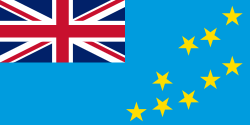 Flag of Tuvalu | |
| Use | National flag and ensign |
|---|---|
| Proportion | 1:2 |
| Adopted | 1 October 1978 (original) April 11, 1997 (readopted) |
| Design | A Light Blue Ensign with a map of the 9 islands, using 9 yellow stars on the fly half of the flag. |
 State flag of Tuvalu | |
| Use | State flag |
| Proportion | 1:2 |
| Design | Same design of the National Flag with the national coat of arms centred on the lower hoist-side quadrant. |
 Flag of the governor-general of Tuvalu | |
| Use | Other |
| Proportion | 1:2 |
| Design | A navy blue field with a crown with a lion centered above a banner that reads "Tuvalu". |


The national flag of Tuvalu was instated when the country became independent in 1978, after the separation from the Gilbert and Ellice Islands in 1976.






